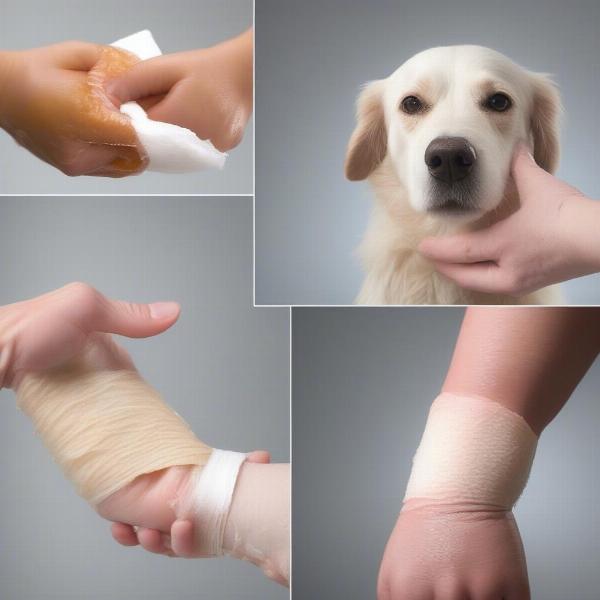Dog bites, particularly to the arm, can be a frightening and painful experience. Understanding why dogs bite and knowing how to prevent such incidents is crucial for both dog owners and anyone who interacts with dogs. This article will delve into the reasons behind dog bites to the arm, offer practical advice on prevention, and provide guidance on what to do if a bite occurs.
A dog might bite an arm for a variety of reasons, including fear, territoriality, pain, or resource guarding. Puppies may also nip during play, which can escalate to biting if not addressed. Recognizing the signs of a dog’s discomfort, such as flattened ears, a tucked tail, or lip licking, can help you avoid a potentially dangerous situation. Proper training and socialization are key to preventing dog bites.
Why Do Dogs Bite Arms?
Dogs don’t bite without reason. Understanding these reasons is the first step towards preventing bites. Common triggers for arm bites include:
- Fear: A frightened dog may bite defensively if it feels cornered or threatened. Reaching out suddenly towards a fearful dog, especially to its face, can trigger a bite to the arm.
- Territoriality: Some dogs are protective of their space, food, toys, or even their owners. Approaching a dog while it’s guarding something it values can provoke a defensive bite.
- Pain: A dog in pain may bite if its discomfort is aggravated, even unintentionally. Be cautious when handling a dog that’s injured or showing signs of illness.
- Resource Guarding: This behavior stems from a dog’s possessive nature, protecting valued items. Attempting to take away a toy or treat from a dog exhibiting resource guarding can lead to a bite.
- Play Aggression: While puppies often nip during play, it’s essential to teach bite inhibition early on to prevent this behavior from escalating into more serious bites as the dog matures.
Preventing Dog Bites to the Arm
Prevention is always better than cure. These preventative measures can significantly reduce the risk of dog bites:
- Socialization: Expose your dog to various people, environments, and situations from a young age. This helps them become well-adjusted and less likely to react fearfully or aggressively.
- Training: Obedience training teaches dogs appropriate behavior and strengthens the bond between dog and owner. A well-trained dog is less likely to bite.
- Recognize Body Language: Learn to interpret canine body language. Avoid approaching a dog showing signs of stress, fear, or aggression.
- Respect Their Space: Never approach a dog without the owner’s permission. Avoid staring directly into a dog’s eyes, as this can be perceived as a challenge.
- Teach Children How to Interact with Dogs: Children are particularly vulnerable to dog bites. Teach them to approach dogs calmly and respectfully, never to tease or pull their tails, and to ask permission before petting a dog.
What to Do if a Dog Bites Your Arm
If a dog does bite your arm, seek immediate medical attention, even if the wound seems minor. Clean the wound thoroughly with soap and water and apply a bandage. Report the bite to the appropriate authorities.
 Dog Bite First Aid
Dog Bite First Aid
Conclusion
Dog bites to the arm are preventable with proper understanding and precautions. By learning to recognize a dog’s signals, practicing responsible dog ownership, and educating ourselves and our children about safe interactions with dogs, we can minimize the risk of these painful incidents. Remember, a well-socialized and trained dog is a happy and safe dog, promoting a harmonious relationship between humans and their canine companions.
FAQ
- Why do dogs bite children more often? Children often interact with dogs at their level, making direct eye contact and engaging in sudden movements, which can be perceived as threatening.
- How can I tell if a dog is about to bite? Look for signs like stiff posture, bared teeth, growling, a fixed stare, and raised hackles.
- Should I punish a dog for biting? Punishment is rarely effective and can exacerbate aggression. Focus on positive reinforcement training and addressing the underlying causes of the biting behavior.
- What is the best way to approach an unfamiliar dog? Approach slowly and calmly, allowing the dog to sniff your hand before attempting to pet it.
- Are certain dog breeds more prone to biting? Any dog can bite, regardless of breed. However, some breeds may be genetically predisposed to certain behaviors that increase the risk of biting.
- What should I do if a stray dog approaches me aggressively? Stand still, avoid eye contact, and slowly back away. Do not run, as this may trigger a chase response.
- Is it safe to approach a dog that is eating? It’s best to avoid approaching a dog while it’s eating, as this can trigger resource guarding behavior.
ILM Dog is your trusted resource for all things canine. We offer expert advice on dog breeds, health, training, nutrition, grooming, and much more. Whether you’re a seasoned dog owner or just starting out, we can help you navigate the joys and challenges of canine companionship. For expert advice, contact us at [email protected] or call +44 20-3965-8624. Visit ILM Dog for more valuable insights and information on dog care.